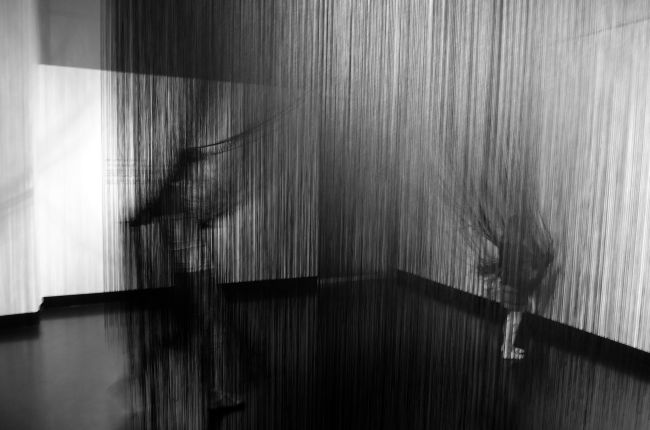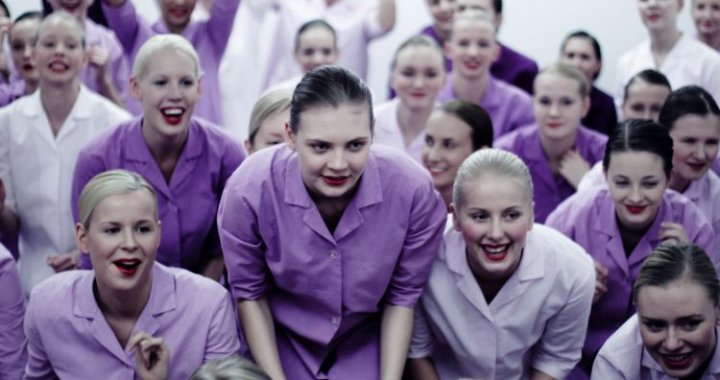
Clothes... Quiet and Faithful Companions
Interview with Estonian Artist and Fashion Designer, Marit Ilison
Keiu Krikmann
04/02/2014
The artist and fashion designer Marit Ilison has been making waves in the Estonian fashion scene for a number of years now. Despite of being well appreciated in her home country as well as abroad – she has just been selected to be among the 10 finalists of the notable international fashion competition Hyères – she does not seem to enjoy being in the centre of attention. Marit has her own way of approaching fashion – rather than focusing on trends, she wants the clothes she designs to be like quiet and faithful companions for the person wearing them. And that’s what is so fascinating about Marit and her designs – a sense of balance and thoroughness. That also comes through in the following interview, in which we discussed her newest projects and the various motivations behind her work.

Lúmine, 2008. Photo by Maiken Staak
Could you talk a little about your background and what led you to become a designer? Were you more interested in making things, or was it the fashion world that evoked your interest?
I have always been interested in making things with my hands, and I always made clothes for my dolls. In school, I made the most complicated vests and aprons, but I never finished any knitting tasks. In 8th grade, I was inspired by my desk mate and started to stitch my own clothes. I got some patterns from my godmother, who is a pattern-maker, and since then, I’ve been in this “business”. Despite having the best grades, I pursued vocational pattern-maker studies after high school because I was convinced that I was not creative enough to become a designer. I didn’t know anything about “looking for inspiration”, and when I intuitively did that, I thought I was stealing, and that these were not my original creations.
I know now that choosing technical studies has been the best choice of all – a true base for everything else. After that followed MA studies at the Estonian Academy of Arts and at the Danish Design School, and internships at various fashion studios. I was then shocked (during the internships) when I saw how much of a copycat fashion actually is!
I am very curious about how the system works – how are things made, what is the system and hierarchy like from inside etc., not so much in just creating collections season by season. I find that everything you do should have a meaning and reason to be made.
You have been called a fashion intellectual and a conceptualist – how do you feel about these labels? Do you identify with those descriptions?
I don’t like labeling, but labels or themes are something that people can relate to. You are in this box, and someone else is in that other box, and then, maybe, people understand the backgrounds of the works better. I definitely like creating works with meanings, which through their appealing visual look, lead people to the meaning and concept behind the work. It feels good if I can evoke feelings, and propose a different view to the subject than people are used to.
Could you describe the way you work? Do you usually start off with a concept, or is it rather the materials, or shapes, that ignite the creative process?
I think a lot. I am an absolute over-thinker, in every aspect. I usually get some visuals in my head, and then I start looking for their meaning. I run through tons of ideas and look for the ones that resonate and create good feelings inside me. I see every work as a puzzle that has come together from different bits and experiences that I have been through – visuals, feelings, materials, sounds. They are all flying above my head, and once I’m ready, all of the pieces come together. It’s just something so magical, and the result often has way more layers than I had initially planned. It blows my mind that something that’s visually very simple can actually convey very big ideas.
I’m not good with beautiful sketches, so I rather write things down, or draw technical drawings. The moment of visualizing an idea is often tough, as I can’t find an appropriate image, or it takes such a long time and I become frustrated with such slowness.
As a part of your collection titled Teine, you also presented a t-shirt project, HEAL THY, at this year's Design Night Festival in Tallinn. Could you talk about the t-shirt project in a little more detail? What was the inspiration behind it, and how does it relate to the main collection?
It is a separate project, but I wanted to have a powerful show experience, and they fitted well together. I find that the fashion show, as a format, is actually very, very primitive, and often, very emotionless; especially nowadays, when it’s more and more perceived via a small screen in the viewer’s hand, and just to ironically “capture the moment”. It is basically a judging panel – do I (as a viewer) like the look, or not? And it is the same with each look – next, next, next. A raving mass of 70 people – with flashing strobes and powerful music – left everybody with a feeling: be it surprise, a smile, or power.

The presentation of HEAL THY at the Design Night Festival in Tallinn, 2013. Photo by Pille Epner
HEAL THY is a project about starting to change the world from within – loving and caring about yourself first. Heal your life, your home, your friends etc. Very simple things, like having enough sleep; eating good food; buying less, but better quality; sleeping in bed linen you love; enjoying the little things. All of these things create positive emotions that will, eventually, make the world a better place.
The t-shirts are very minimal – reused, reversed, reworked and printed black on black with HEAL THY graphics. They’re not boldly screaming out the message, but rather, they express the small and quiet changes within oneself. I chose to use old t-shirts because there are so many in the world already, and I don’t see any point in creating more. Plus, the old ones have a cool and natural washed-out look, that would mean extra chemical treatment to otherwise achieve the same look. I also like the idea of reassigning value to something that has actually already been thrown away.
Even though in the HEAL THY project you use recycled t-shirts, you've said in a previous interview that at one point in your life, at the time when sustainability, recycling and second-hand were becoming a huge trend, you felt that you had done enough, that you had done your share of recycling, and that as a designer, you wanted to move on. I thought it was really refreshing to hear you say that, and I was wondering if you could discuss that a little further.
Yes. When recycling became big in the middle of the 2000s, I really didn’t want to do anything with it. I wore so many second-hand clothes as a child, just because there weren’t any other options for our family in the middle of the 1990s – after Estonia got its independence back. So, I felt I really had already reached my life’s responsible sustainability-share limit. Reused clothes reminded me of the feeling that you can never have something new, something that is your own and personal to you; it reminded me of the feeling you get when you have to accept “those wonderful things” that some family acquaintance has cleaned out from their closets. Feelings that make you feel inferior, not good enough, and sad.

Lúmine, 2008. Photo by Maiken Staak
I have now distanced myself from it, because I have a choice. And now, I often see traces of conflict and nostalgia in my work, and I find myself working with things I’m irritated by. I see it as a challenge to transform that irritation into something pleasant. To see the potential for good in everything, and to mould the irritant into a form that I can accept. It is especially interesting with sounds, when we’re creating music with our band (Väljasõit rohelisse – K.K.), and HEAL THY is also a good example.
One of the most memorable of the recent fashion-related events for “ordinary” Estonians was, probably, the opening of the first H&M stores in the country, which provoked contrasting reactions. Do you have any strong feelings about fast fashion, and do you feel it affects you as a designer in any way?
The main thing I feel is that the centre of our city has transformed. Now, especially with the warm winter and no snow, the space with that big, red logo feels exactly like some random intersection in any random Central European city. I feel like we have lost something – a bit of the free atmosphere. The space is now uniformed, and this big logo has clothed the city.
In terms of clothing, I think that fast fashion is fueled by the basic human fear of not being worthy enough, and the hunger for love and acceptance. Excessive buying feeds the empty holes of our emotional needs, but as with every addiction, the more you get, the more you want. And this circle is well-supported by the low-quality “wear-two-times” products. But we don’t need so many clothes; trendy pieces don’t make anyone a better person. And when you really think about what kind of conditions the clothes are made in – like when a factory is producing and dyeing blue t-shirts, thereby making the whole water in the area blue – you don’t want to go into that shop. I also have several H&M pieces, but most of them I’ve worn for 5-7 years, hundreds and hundreds of times, I like them a lot, and I will keep wearing them.
Teine. Installation. Hop Gallery, 2013
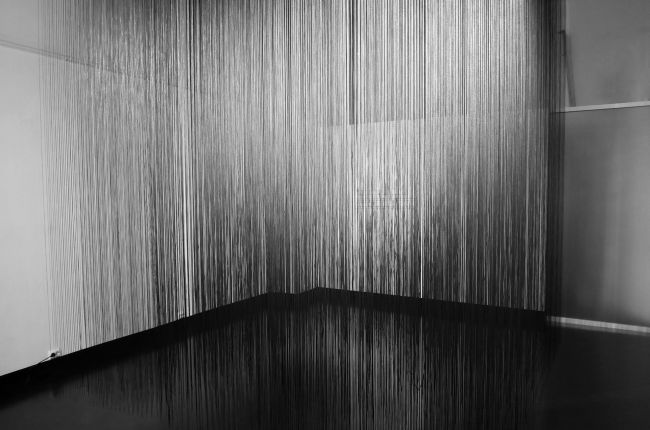
So, I hope the crazy system will start to change. The function of “the fashion week” has changed; more and more slow fashion companies are coming to the market, and people are becoming more conscious. Fashion has to become honest and transparent. As a designer, I don’t care about trends, and I want to make things that stay around for a long time, like good friends whom you care about, and who take good care of you.
I think clothes can be among the most meaningful and personal objects a person can own, and I know that in your practice, you focus on the intimate space between a person and their clothes. How do you think those personal links are formed – can a designer facilitate them? And with that in mind, what do you think is the difference between garments that are mass produced, and those that are not? Do you think people connect to them differently, or have different attitudes towards the two?
I am not concentrating on a deeper connection between a person and their garment. I’m interested in creating a comfortable space, where the wearer actually can forget about the piece of clothing. Everything comes together within the fit and materials, and in this case, a designer can choose good materials and create comfortable cuts. But in general, I don’t think that a designer can make anybody like something. It’s interesting to see how people find “their pieces” from my collection. How something just “feels right”, and something does not. I think it has to do with our sense of beauty and harmony. I believe that everything is made out of an energy that resonates at some level, and when that sequence is similar to the wearer's sequence, they create a harmony. And this is the reason why something feels “yours” – it creates harmony within you. Regarding mass production and custom made pieces, it is, again, about that feeling of feeling special, and evaluating the source. It’s like either picking your first home-grown tomatoes, or choosing some from the hundreds of “plastic-tasting” ones at the supermarket.
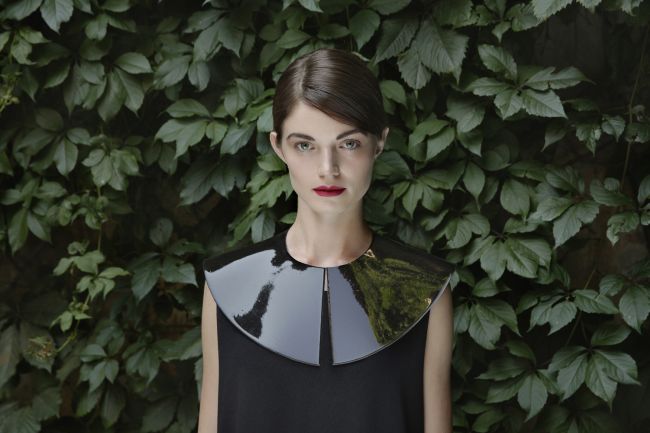
Teine, 2013. Photo by Riina Varol

In addition to presenting your new collection, you've been busy with quite a number of other things as well. For example, you took part in the Tallinn Light Biennale with a collection from 2008, titled Lúmine; you had a personal exhibition where you displayed the installation Teine at the Hop Gallery. You've also completed the project Longing For Sleep, which you recently showed at the Kaamos exhibition at the Estonian Museum of Applied Art and Design, and which you will soon be taking to London Fashion Week in February – could you describe the project within a few words?
Longing for Sleep is a project that has been coming together for over ten years, and was executed only now, when I was asked to take part in the Kaamos – Estonian Fashion Now exhibition. Rather than visually interpreting kaamos (a word only known in the Estonian and Finnish languages, referring to the time between November and January – K.K.) – something dark or negative – I worked with the feeling that I have at that wintry time – a constant wish to sleep and stay between the sheets all day. I’ve borrowed the name from the Estonian title of Anton Checkhov’s short story, Let Me Sleep, and just like in this story, where a girl called Varka can’t sleep because she has to look after a baby who is constantly crying, I can’t fully rest because of my guilty conscience: that instead of sleeping, I should be working.
So, I’ve created a collection of coats made out of old Soviet blankets, which are often thrown away these days, but which I see as a wonderful material to work with.
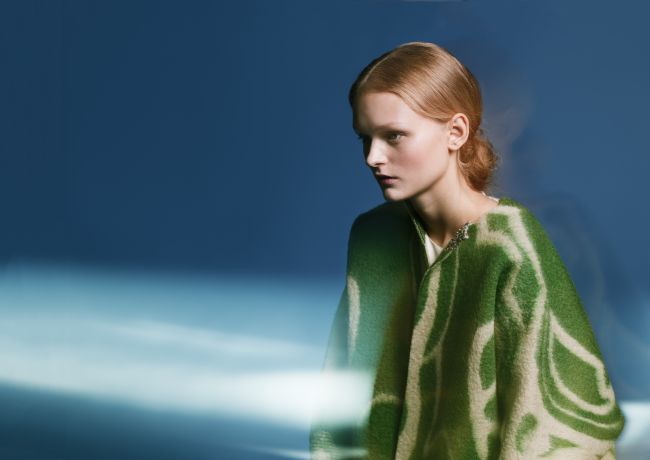
Longing For Sleep, 2013. Photo by Maiken Staa
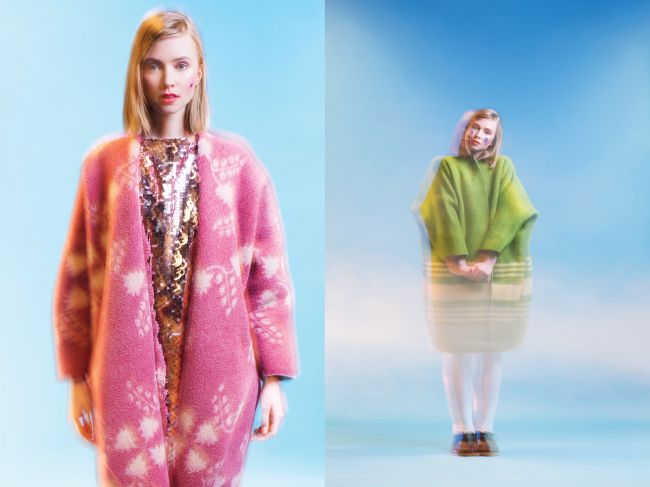
And on top of everything already mentioned, you also teach at the Estonian Academy of Arts. Your students have taken part in the ERKI fashion show, with their experimental forms, for years now, and sometimes it seems like it also gives you the opportunity to do something rather different from your everyday work. For example, I'm thinking of the Fashion Empowerment project from 2011, in which you supervised a group of students who designed clothing for people with different disabilities. How does the teaching experience factor into your own practice – has it influenced you as a designer, or as a person?
The teaching experience definitely influences me a lot. Every project, every course, every student is a new lesson. I need to be updated and know a little more in any subject before they take any next step. They open up my world with new themes and insights, and it inspires me a lot. I also learn how to communicate myself and my works better. And actually, it is not different from my daily work; it’s all what I do on a daily basis, I just share my practical experience and knowledge. The Fashion Empowerment project was a special one, as it made me think more about “the feeling”. One group of students worked with blind people, and their designs came out amazingly cool and beautiful, but besides that, they also felt good, because a blind person can’t sacrifice her own comfort for the appreciative looks that she might get from others. She has to feel good all the time. I can say that, since then, this has been my principle for my own designs.

Fashion Empowerment, 2011. Photo by Tarvo Hanno Varres
The last question I have is about the context in which you create your designs. In addition to Estonia, you've studied and worked in London, Copenhagen, Antwerp and Berlin, and shown your work in various regions of the world. Do you think Estonia is a good place for a designer to work in? I mean, in terms of industry, it does not have much to offer – is that an issue for you, or do you feel that you can do enough here? Are you not afraid of missing out somehow?
I’ve chosen to work here, at the moment, because of personal reasons – my friends are here, I like the quiet pace of living, the good living conditions, and the natural environment. But we have don't have a market, and this can’t be fixed because we just have so few people, and the standard of living and design-awareness are low.
So, Estonia is a good, small place to create your things to send out to the world. Here I can test and try things that I couldn’t do and afford anywhere else, but it’s really difficult to get out from here, just even transport-wise. And when it comes down to making anything new and different, it’s hard to find materials, even some very basic ones, because we have no specialty shops and it’s expensive to import anything. To really succeed, you need contacts and a supportive network, both here and abroad.
